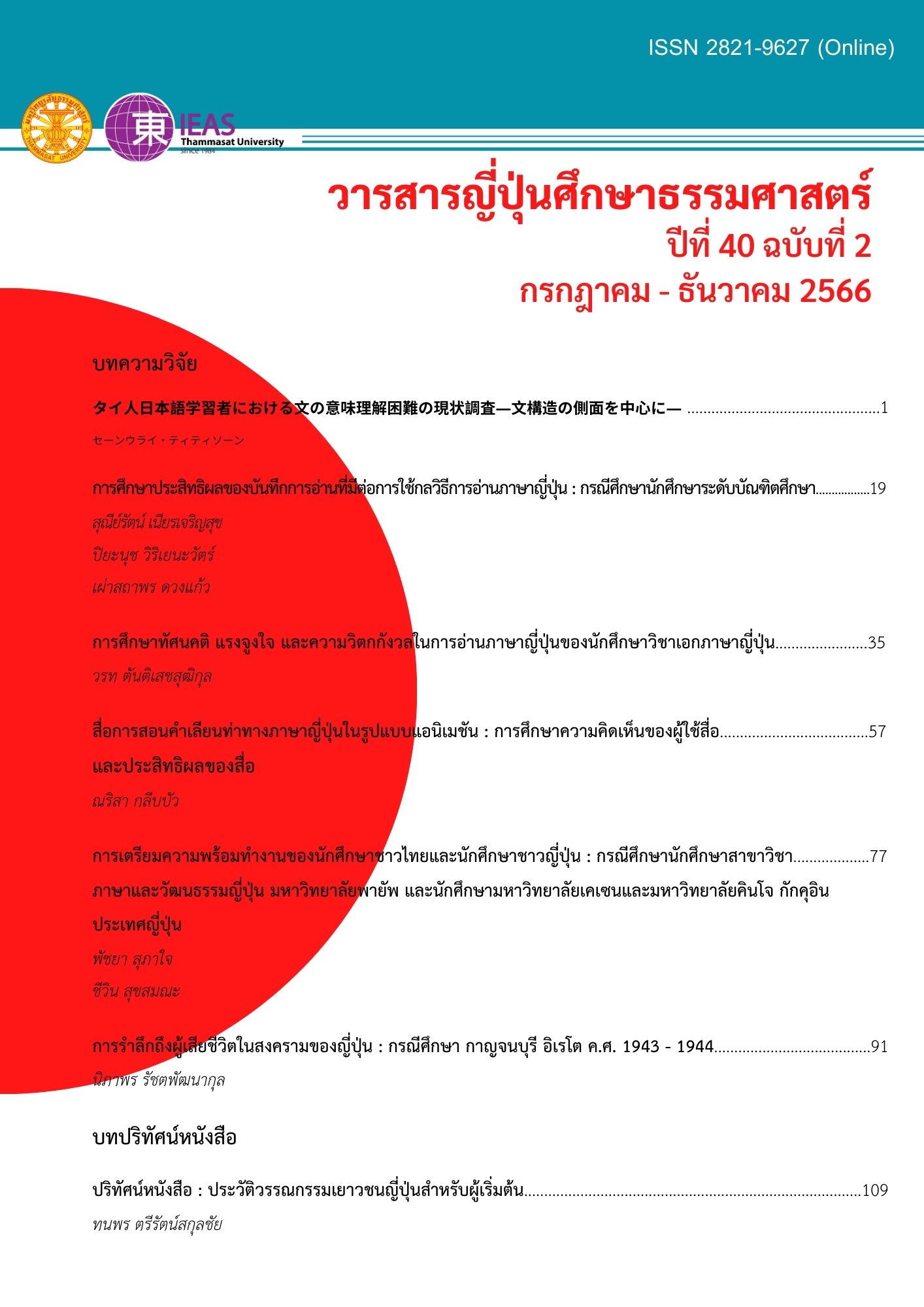Investigating of Reading Attitudes, Motivation, and Reading Anxiety of Thai Students Majoring in Japanese
Keywords:
Reading attitude, Reading motivation, Reading anxiety, UndergraduatesAbstract
This study investigated reading attitudes, reading motivation, and reading anxiety of 99 Thai undergraduates majoring in Japanese. Two groups with different backgrounds were investigated: beginning and intermediate. Some had experiences studying Japanese before attending university, while others did not. Research instruments were adapted from the foreign language reading attitude and motivation scale (FLRAMS) developed by Erten, Topkaya, and Karakas and the foreign language reading anxiety scale (FLRAS) of Saito, Horwitz, and Garza. Final questionnaires were divided into three scales: 1) attitudes about reading Japanese; 2. motivation to read Japanese; and 3) anxiety about reading Japanese.
Results indicated a significant different between beginning and intermediate levels in reading and reading anxiety. In terms of attitudes, intermediate students felt that succeeding to read Japanese would be helpful in future more than did beginners. In terms of reading anxiety, a significant difference existed between students experienced or inexperienced in studying Japanese. The correlation among attitude, motivation, and anxiety in reading Japanese showed a significant positive correlation between attitude and motivation. The more positive the attitude, the higher motivation to read. There was a significant negative correlation between motivation and anxiety, so the higher anxiety, the less motivation is noticeable.
Downloads
References
เตวิช เศวตไอยาราม. (2559). กลยุทธ์การอ่านของผู้เรียนภาษาญี่ปุ่นชาวไทยที่มีความสามารถต่างกัน. วารสารญี่ปุ่นศึกษา, 33(3), 59-78.
ทัศนีย์ เมธาพิสิฐ, น้ำทิพย์ เมธเศรษฐ, สมเกียรติ เชวงกิจวณิช และ สุณีย์รัตน์ เนียรเจริญสุข (2546). การสำรวจความต้องการของนักเรียนที่เรียนภาษาญี่ปุ่นในมัธยมศึกษาตอนปลาย. วารสารศิลปศาสตร์มหาวิทยาลัยธรรมศาสตร์, 3(1), 131-144.
ยุพกา ฟูกุชิม่า, กนกพร นุ่มทอง และ สร้อยสุดา ณ ระนอง. (2556). ความนิยมในการเรียนภาษาญี่ปุ่นและภาษาจีน ของนิสิตมหาวิทยาลัยเกษตรศาสตร์: แรงจูงใจแตกต่างกันอย่างไร. วารสารญี่ปุ่นศึกษา, 30(1), 27-40.
อมรรัตน์ มะโนบาล และเตวิช เสวตไอยาราม. (2560). การศึกษาความวิตกกังวลในการเรียนรู้ภาษาญี่ปุ่นของผู้เรียนระดับต้นที่มีพื้นฐานภาษาญี่ปุ่นแตกต่างกัน. วารสารเครือข่ายญี่ปุ่นศึกษา, 7(1), 33-50.
Alexander, J. E., & Filler, R. C. (1976). Attitude and Reading. International Reading Association.
Carrell, P. L., & Grabe, W. (2002). Reading. In N. Schmitt (Ed.), An introduction to applied Linguistics (pp. 233-250). Arnold
Christopher, D. L. (2018). Motivation, Proficiency and Performance in Extensive Reading. International Journal of Innovation and Research in Educational Sciences, 6(3), 442-453.
Erten, I. H., Topkaya, Z. E., & Karakas, M. (2010). Exploring motivational constructs in foreign language reading. Hacettepe University Journal of Education, 39, 185-196.
Guthrie, J. T., Wigfield, A., & VonSecker, C. (2000). Effects of integrated instruction on motivation and strategy use in reading. Journal of Educational Psychology, 92(2), 331-341.
Ipek, H. (2009). Foreign language reading anxiety: proficiency and gender. The international Journal of Learning, 16, 293-299.
Jain, Y., & Sidhu, G. (2013). Relationship between Anxiety, Attitude and Motivation of Tertiary Students in Learning English as a Second Language. Procedia - Social and Behavioral Sciences, 90, 114-123.
Krashen, S. D. (1982). Principles and practice in second language acquisition. Pergamon Press.
Macintyre, P., & Gardner, R. (1991). Methods and results in the study of foreign language anxiety: A review of the literature. Language Learning, 41, 85-117.
Marinak, B. A., & Gambrell, L. B. (2008). Intrinsic Motivation and Rewards: What Sustains Young Children's Engagement with Text? Literacy Research and Instruction, 47, 9-26.
McKenna, M., Kear, D., & Ellsworth, R. A. (1995). Children’s attitudes toward reading: A national survey. Reading Research Quarterly, 30, 934-956.
Ölmez, F. (2015). An investigation into the relationship between L2 reading motivation and reading achievement. Procedia - Social and Behavioral Sciences, 199, 597-603.
Ryan, R. M., & Deci, E. L. (2000). Intrinsic and extrinsic motivations: Classic definitions and new directions. Contemporary Educational Psychology, 25, 54-67.
Saito, Y., Horwitz, E., & Garza, T. (1999). Foreign language reading anxiety. The Modern Language Journal, 83(2), 202-218.
Senturk, B. (2015). EFL Turkish university students’ attitudes and motivation towards reading in English. Social and Behavioral Science, 199, 704-712.
Tisa, F., Sofendi, S., & Eryansyah, E. (2021). Reading and its relationships among attitude, motivation, and comprehension achievement in upper secondary school students. Journal of English Educators Society, 6(1), 42-51.
Torudom, K. (2016). An Investigation of Reading Attitudes, Motivation, and Reading Anxiety of Undergraduate Students. [Unpublished master’s thesis]. Thammasat University.
Torudom, K., & Taylor, P. (2017). An Investigation of Reading Attitudes, Motivation and Reading Anxiety of Undergraduate Students. Language Education and Acquisition Research Network Journal, 10, 47-70.
Zhao, A., Guo, Y., & Dynia, J. (2013). Foreign language reading anxiety: Chinese as a foreign language in the United States. The Modern Language Journal, 97(3), 764-778.
サグアンシー・タンヤーラット. (2016). 「外国語としての日本語における読解不安・外国語学 習不 安・読解力との関係 : タイ人大学生を対象に」『言語科学研究 : 神田外語大学大学院紀要 』, 22, 45-64.
福本和佳子、印道緑. (2016). 「文脈力をつける読解教育」『北九州市立大学国際論集』14, 157-170.
Downloads
Published
Issue
Section
License
Copyright (c) 2023 Thammasat Journal of Japanese Studies

This work is licensed under a Creative Commons Attribution-NonCommercial-NoDerivatives 4.0 International License.




